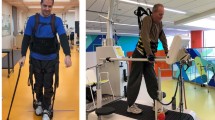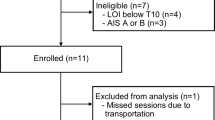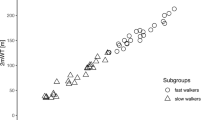Abstract
Study design:
Observational cross-section study.
Objectives:
The objective of our study was to determine if the influence of a community environment would impact on ASIA D spinal cord injured (SCI) gait performance patients. Our main hypothesis is that an outdoor community environment may influence gait speed and endurance on community ambulating patients.
Methods:
Ten-Meter Walking (10MWT) and Six-Minute Walking (6MWT) tests were performed on community ambulating SCI research participants (n=18) in two different environmental conditions: (1) Experimental (indoors Gymnasium) and (2) Natural (community setting). Average gait speed and endurance values were obtained for the two different conditions and analyzed for statistical significance on the nonparametric two-tailed Wilcoxon signed rank test.
Results:
While no difference was observed on the 10MWT we found an improvement on gait performance on the 6 MWT on a community setting.
Conclusions:
Our study showed mixed results on environmental influence on gait speed and endurance on ASIA D patient population. While there is no difference on the 10 MWT, there is an improvement on gait performance on the communitary 6MWT.
Similar content being viewed by others
Log in or create a free account to read this content
Gain free access to this article, as well as selected content from this journal and more on nature.com
or
References
Burns SP, Golding DG, Rolle Jr WA, Graziani V, Ditunno Jr JF . Recovery of ambulation in motor-incomplete tetraplegia. Arch Phys Med Rehabil 1997; 78: 1169–1172.
Crozier KS, Cheng LL, Graziani V, Zorn G, Herbison G, Ditunno Jr JF . Spinal cord injury: prognosis for ambulation based on quadriceps recovery. Paraplegia 1992; 30: 762–767.
Waters RL, Adkins RH, Yakura JS, Sie I . Motor and sensory recovery following incomplete paraplegia. Arch Phys Med Rehabil 1994; 75: 306–311.
Gardner MB, Holden MK, Leikauskas JM, Richard RL . Partial body weight support with treadmill locomotion to improve gait after incomplete spinal cord injury: a single-subject experimental design. Phys Ther 1998; 78: 361–374.
Lapointe R, Lajoie Y, Serresse O, Barbeau H . Functional community ambulation requirements in incomplete spinal cord injured subjects. Spinal Cord 2001; 39: 327–335.
Lord SE, Rochester L . Measurement of community ambulation after stroke: current status and future developments. Stroke 2005; 36: 1457–1461.
Lerner-Frankiel MB, Vargas S, Brown M, Krusel L, Schoneberger W . Functional community ambulation: what are your criteria? Clin Manage 1986; 6: 12–15.
Taylor D, Stretton CM, Mudge S, Garret N . Does clinic-measured gait speed differ from gait speed measured in the community in people with stroke? Clin Rehabil 2006; 20: 438–444.
Perry J, Garrett M, Gronley J, Mulroy S . Classification of walking handicap in the stroke population. Stroke 1995; 26: 982–989.
van Hedel HJ, Wirz M, Dietz V . Assessing walking ability in subjects with spinal cord injury: validity and reliability of 3 walking tests. Arch Phys Med Rehabil 2005; 86: 190–196.
van Hedel HJ, Wirz M, Curt A . Improving walking assessment in subjects with an incomplete spinal cord injury: responsiveness. Spinal Cord 2006; 44: 352–356.
Curt A, Dietz V . Ambulatory capacity in spinal cord injury: significance of somatosensory evoked potentials and ASIA protocol in predicting outcome. Arch Phys Med Rehabil 1997; 78: 39–43.
Lord S, McPherson K, McNaughton H, Rochester L, Weatherall M . Community ambulation after stroke: how important and obtainable is it and what measures appear predictive? Arch Phys Med Rehabil 2004; 85: 234–239.
Bethoux F, Calmels P, Gautheron V . Changes in the quality of life of hemiplegic stroke patients with time. Am J Phys Med Rehabil 1999; 78: 19–23.
Wilkinson PR, Wolfe CD, Warburton FG, Rudd AG, Ross-Russell RW, Beech RR et al. A long-term follow-up of stroke patients. Stroke 1997; 28: 507–512.
Mayo NE, Wood-Dauphinee S, Ahmed S, Gordon C, Higgins J, McEwen S et al. Disablement following stroke. Disabil Rehabil 1999; 21: 258–268.
World Health Organization. International Classification of Functioning, Disability and Health 2001. World Health Organization: Geneva.
Stucki G, Ewert T, Cieza A . Value and application of the ICF in rehabilitation medicine. Disabil Rehabil 2003; 25: 628–634.
Waters RL, Yakura JS, Adkins R, Barnes G . Determinants of gait performance following spinal cord injury. Arch Phys Med and Rehabil 1989; 70: 811–818.
Robinett CS, Vondran MA . Functional ambulation velocity and distance requirements in rural and urban communities. Phys Ther 1988; 68: 1371–1373.
Acknowledgements
Prof Dr Ramòn Leiguarda, MD for his valuable contributions to this publication. FLENI Rehabilitation Institute, Buenos Aires, Argentina.
Author information
Authors and Affiliations
Corresponding author
Rights and permissions
About this article
Cite this article
Olmos, L., Freixes, O., Gatti, M. et al. Comparison of gait performance on different environmental settings for patients with chronic spinal cord injury. Spinal Cord 46, 331–334 (2008). https://doi.org/10.1038/sj.sc.3102132
Received:
Revised:
Accepted:
Published:
Issue date:
DOI: https://doi.org/10.1038/sj.sc.3102132
Keywords
This article is cited by
-
Berg Balance Scale: inter-rater and intra-rater reliability of the Spanish version with incomplete spinal cord injured subjects
Spinal Cord Series and Cases (2020)
-
Validation of the instrumented evaluation of spatio-temporal gait parameters in patients with motor incomplete spinal cord injury
Spinal Cord (2017)
-
Validity and reliability of the 10-m walk test and the 6-min walk test in spinal cord injury patients
Spinal Cord (2011)



